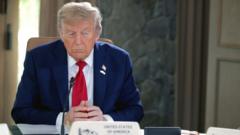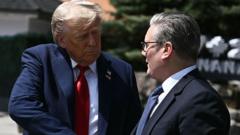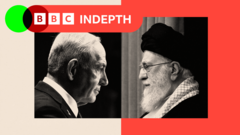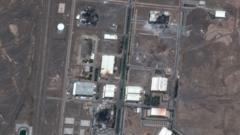As tensions escalate in the Middle East, President Trump's options for addressing Iran's actions grow increasingly complex, with significant implications both domestically and internationally.
**Trump's Dilemma: Navigating Iran Relations Amid Escalating Tensions**

**Trump's Dilemma: Navigating Iran Relations Amid Escalating Tensions**
In light of the Israel-Iran conflict, President Trump's stance toward Iran remains ambiguous as pressures mount from various factions.
President Donald Trump finds himself at a crossroads regarding how to deal with Iran amid escalating tensions triggered by the ongoing conflict with Israel. His evolving rhetoric has ranged from staunch support for Israeli airstrikes against Iranian targets to moments of reticence, reflecting an underlying uncertainty about the best course of action.
Israeli Prime Minister Benjamin Netanyahu has publicly asserted that their military actions are fully coordinated with the United States, adding to the pressure on Trump to align more closely with Israel's aggressive stance. With strikes on Iranian sites intensifying, Trump recently warned that Iran's leadership could face even harsher consequences from Israel, which is armed with American munitions.
Trump's primary objective seems to align with Netanyahu's: ensuring Iran does not attain nuclear capabilities. While he has articulated a preference for negotiating a deal with Iran—a reflection of his self-identified role as a master dealmaker—his strategy has included both threats of military force and calls for diplomacy. Importantly, Trump has recently suggested that a potential Israeli attack could either pave the way for negotiations or derail them entirely.
This unpredictability has led some supporters to liken his strategy to the "madman theory," which posits that projecting uncertainty can compel adversaries—and allies—to comply with U.S. demands. His advisory circle includes proponents of a “maximum pressure” approach toward Iran. They contend that demonstrating military resolve will ultimately coerce Tehran into negotiations, despite the legacy of the 2015 nuclear deal that Trump dismantled.
As the conflict continues, Netanyahu appears to advocate for an intensified military response, potentially including strikes against key Iranian figures, though an anonymous U.S. official indicated Trump opposes such direct action. Despite his self-imposed image as a peace-promoter, Trump may still feel compelled to respond to pressures from prominent Republican hawks who favor dramatic measures against Iran.
Conversely, a faction of Trump’s base, particularly within the Make America Great Again (MAGA) movement, is advocating for a less interventionist stance. Voices within this camp, including influential media figures, are questioning the wisdom of direct U.S. military entanglement in conflicts abroad, urging a greater focus on "America First" policies. Criticisms from loyal allies highlight a potential divide that could influence Trump’s decisions moving forward.
Moreover, recent developments indicate that Trump is beginning to show signs of distancing the U.S. from Israel’s military operations. In public discourse, he has echoed sentiments alongside figures like Russian President Vladimir Putin, advocating for an end to hostilities and emphasizing that the U.S. was not involved in recent escalations.
However, should American casualties arise from retaliation by Iran, it could substantially amplify the isolationist arguments within Trump’s political base, further complicating his strategic options. Thus, Trump faces the dual challenge of managing internal political pressures while navigating a highly volatile international situation, all while shaping his legacy amidst ongoing conflicts in the Middle East.






















